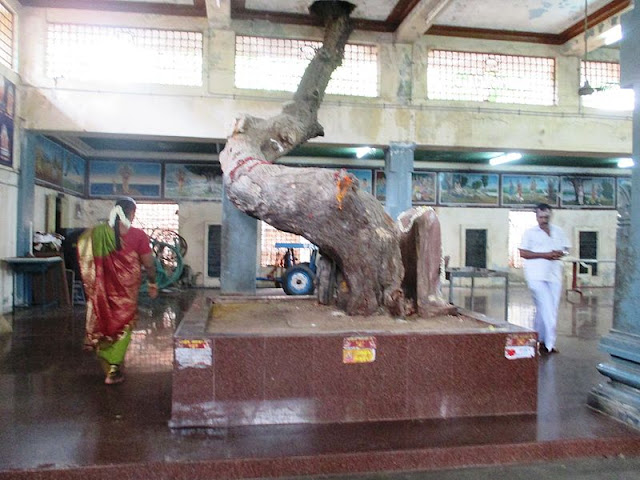Vayalur Murugan Temple – The Temple
This is
actually a Shiva temple but more prominence is given to Lord Muruga. The temple
is surrounded on all four sides by lush green fields. The Temple is facing east
with three tiered Rajagopuram and having two prakarams. The outer prakara is
320 feet in length facing east-west direction and 87 feet in breadth in the
north-south direction. The Second prakaram can be accessed via New Gopuram and
Shiva sannidhi is located in this prakara. Presiding Deity is called as Adhinathar.
Lord is a Swayambu Moorthy in this temple.
There
are Dwajasthambam, Balipeedam and the statue of Nandhi facing towards sanctum
sanctorum of Lord Adhinathar. Mother is called as Adhi Nayaki Amman / Munnilai
Nayaki. While the Goddess is seen facing North in almost all Shiva temples,
Mother Adhi Nayaki here is facing south. Lord Nataraja appears here as
Soorathandavamurthy. The Thandava posture of Lord Nataraja is worth
seeing. Tiruvasi and Muyalagan (dwarf-demon) at his feet are not found. It is a
very rare idol.
Vinayaka
of this place is known as Poiyya Vinayakar and it is believed that Vinayaga blessed
Arunagirinathar during his visit to this Temple. Poiyya Ganapathy Shrine is
located in between the Shrines of Arunagirinathar and Subramanya Swami. He is
believed to emancipate mankind from the falsehood of life centered on the
senses and help in Self-realization. The Lord holds the pomegranate fruits
which symbolizes the universe or in other word fullness.
Daily
poojas are commenced only after Lord Muruga worshipped his parents (Adhinathar
and Athinayaki). That is why; Lord Siva is also called as Kumara Poojithanathar.
He is also praised by the names of Vidanga Peruman, Mahadevar and Agneeswarar. Though
Shiva is the main deity importance is given to Lord Muruga. Lord Muruga Shrine
is located behind the Moolavar Shiva Sannathi. He is giving darshan with his two consorts, Valli
and Deivayanai. All are in standing position.
Lord
Muruga is single faced with four hands. He is in a standing posture facing east
with the peacock behind him. Another noteworthy feature here is that the
peacock is turned towards Deivanai on the left of the Lord. The Utsava
Murti or processional deity is a metal icon and known by the name Muthukumara
Swami. He is seated on the peacock. The peacock (vehicle of Lord Muruga) is
facing north in the sanctum sanctorum known as Deva Mayil (divine peacock).
The
Sakthi Theertham (Agni Theertham), the holy spring was created by Lord Muruga
with his Vel to worship his parents. Sakthi Theertham is located in front
of the temple on southeast side. Teradiyan Shrine is located near the Theertham.
Sthala Vriksham is Vanni Maram (Vanni tree) is seen in the left side
from the entrance of Rajagopuram. Lord Murugan is also called Vayaluran,
Adi Kumaran, Vannitalakumaran and Muthukumara Swami.
In the
spacious prakara mandapam, puranic pictures depicting Kandapuranam can be seen.
Navagrahas are located in the northeast corner of the temple. Suryan with his
two consorts (Devis) Ushadevi and Sayadevi are in standing position; all other
eight grahams are in standing position facing towards Surya. It is believed
that all doshas (misfortunes) caused by these grahams are being wiped out by
the blessings of Lord Surya as well as by Lord Muruga.
Shrines
of Arunagirinathar and Vinayagar are located in the south and the Shrines of
Mahalakshmi and Navagraha in the North of the second Prakaram. Keela Pillaiyar
and Mela Pillaiyar Shrines are located in the second prakaram. Lord Muruga
appears here to teach the great lesson that one should know that the first Gods
are the Mother and Father. He is seen praying to Lord Shiva and Mother
Parvathi to illustrate this great lesson.
Lord
Muruga gave darshan to Arunagiriar in his wedding form. Hence worship in
the temple would facilitate marriages delayed earlier. Sage Arunagiri had
special attachment to this temple as he gained his poetic skill with the blessings
of Lord Muruga here. A temple made famous with the painstaking efforts of
Sri Kripanandavariar.





































